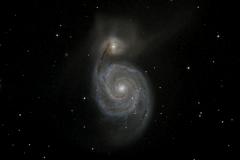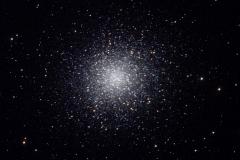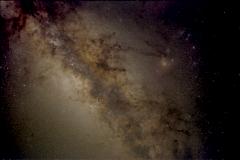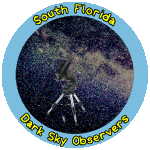Fred Lehman
I just acquired an SXVF-M8C camera, and miraculously I only had to wait a
few days for clear skies. By early afternoon a large mass of stable dry
air was situated just offshore Cape Sable, and most fortuitously the upper
level winds were light and were coming directly from the southwest. I
estimated that the entire southwestern corner of the Florida peninsula
would be completely clear by sunset, so I sneaked out of work early and
loaded up my equipment and headed off to KSRP (Kirby Storter Roadside Park).
I was not disappointed by my guess of the nighttime weather, as conditions
could not have been better. There were no clouds or haze, the air was
stable and dry, and even the brightest of the stars were not twinkling.
There was not as much as a breath of wind and the nighttime temperature did
not drop low enough to reach the dew point, so there was no dew at all (not
even at 2AM). To top it all off, I did not encounter a single mosquito
during the entire evening (zero, zilch, none). I don't know what happened
to all the mosquitoes, but maybe the gigantic oil slick in the Gulf has
exterminated them (good riddance).
Sunset comes late this time of year and the twilight is long, and since
moonrise was somewhat before 2 AM, I only had time for three quick
snapshots during the short period of darkness. First, I focussed my
telescope on the enigmatic galaxy pair NGC5194 & NGC5195 (aka M51). After
a couple of hours I felt I had collected a sufficient number of its 25
million year old photons, so I slewed the scope over to the largest of the
northern globular clusters, NGC6205 (aka M13). Since M13 is 1000x closer
than M51, its photons are a lot younger and brighter so single hour was
more than enough to resolve the cluster into stars. After that, I only
had about 45 minutes till moonrise, so I outfitted the camera with a
wide-field lens and spent the remainder of the darkness capturing photons
coming from the region of sky surrounding the constellation Scorpius.
The darkness of this site is uncanny. At midnight, I measured the
background skylight at 22.3 magnitude, plenty dark for good imaging.
| SXVF-M8C on an LX200-14 @ f/1.98 |
 Whirlpool Galaxy M51
Whirlpool Galaxy M51
in Canes Venatici
|
 Globular Cluster M13
Globular Cluster M13
in Hercules
|
| SXVF-M25C with 24mm Nikkor lens @ f/2.8 |
| |
 Wide-field Photo
Wide-field Photo
of Sagittarius
|
|
The M8C is really a nice camera with very tiny pixels that are great for
short focal length telescopes. My scope is only 700mm yet the camera
reaches down to 0.9 arcseconds per pixel. Since it has four million of
them tiny little pixels the field of view is around a half degree in size
(35x26 arcminutes).
The SLR camera lens used for the wide-field shot does not have the
crispness of an actual astronomical telescope. Its field of view is 56x38
degrees with a spatial resolution of 1.1 arcminutes per pixel.
Photons don't really get old and dim, I was just having a little fun.
|

